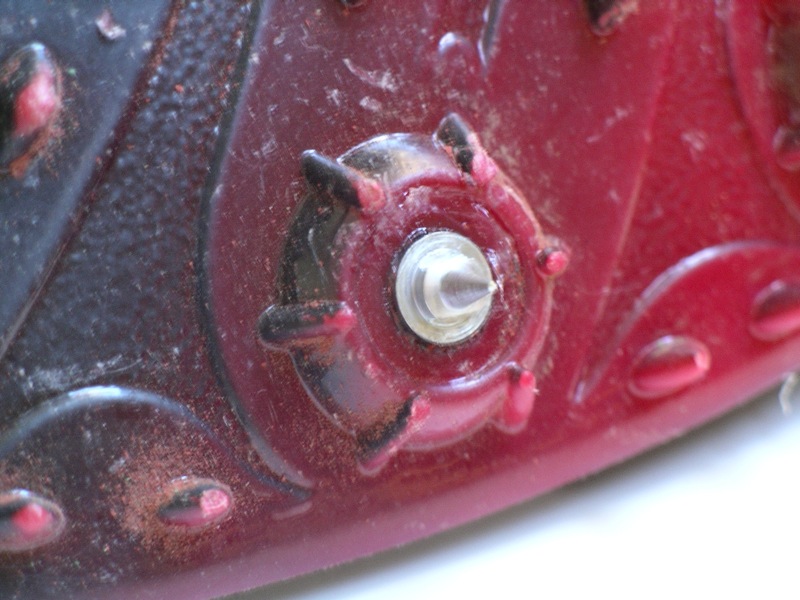|
Spiked Running Shoe
Track spikes, or just spikes, are a type of footwear featuring protruding spikes on the soles used by athletes when racing on the track. Some spikes are designed for longer-term training on tracks, but generally the shoes are used for racing. The term "spikes" can also refer to track shoes featuring such protrusions, though these are technically called pins. Spikes are similar to studs, which are used for team sports, although generally smaller and with a sharp point. History Track spikes had become popular in England by the 1860s, but the concept of spikes in shoes to give running traction has been around much longer. As written in the 1852 publication of ''Calmet's Dictionary of the Holy Bible'' regarding military arms at the time of Paul the Apostle (c. 5 – c. 67): For pioneering the use of spikes, J.W. Foster and Sons's revolutionary running pumps appear in the book, ''Golden Kicks: The Shoes that changed Sport''. The company began distributing shoes across the Unite ... [...More Info...] [...Related Items...] OR: [Wikipedia] [Google] [Baidu] |
Hammer Throw
The hammer throw is one of the four throwing events in regular track and field competitions, along with the discus throw, shot put and javelin. The "hammer" used in this sport is not like any of the tools also called by that name. It consists of a metal ball attached by a steel wire to a grip. The size of the ball varies between men's and women's competitions. History With roots dating back to the 15th century, the contemporary version of the hammer throw is one of the oldest of Olympic Games competitions, first included at the 1900 games in Paris, France (the second Olympiad of the modern era). Its history since the late 1960s and legacy prior to inclusion in the Olympics has been dominated by Europe and Eastern European influence, which has affected interest in the event in other parts of the world. The hammer evolved from its early informal origins to become part of the Scottish Highland games in the late 18th century, where the original version of the event is st ... [...More Info...] [...Related Items...] OR: [Wikipedia] [Google] [Baidu] |
Discus Throw
The discus throw (), also known as disc throw, is a track and field event in which an athlete throws a heavy disc—called a discus—in an attempt to mark a farther distance than their competitors. It is an ancient sport, as demonstrated by the fifth-century-BC Myron statue ''Discobolus''. Although not part of the current pentathlon, it was one of the events of the ancient Greek pentathlon, which can be dated back to at least 708 BC, and it is part of the modern decathlon. History The sport of throwing the discus traces back to it being an event in the original Olympic Games of Ancient Greece. The discus as a sport was resurrected in Magdeburg, Germany, by gymnastics teacher Christian Georg Kohlrausch and his students in the 1870s. Organized men's competition was resumed in the late 19th century, and has been a part of the modern Summer Olympic Games since the first modern competition, the 1896 Summer Olympics. Images of discus throwers figured prominently in advertising for ... [...More Info...] [...Related Items...] OR: [Wikipedia] [Google] [Baidu] |
Shot Put
The shot put is a track and field event involving "putting" (throwing) a heavy spherical ball—the ''shot''—as far as possible. The shot put competition for men has been a part of the modern Olympics since their revival in 1896, and women's competition began in 1948. History Homer mentions competitions of rock throwing by soldiers during the Siege of Troy but there is no record of any dead weights being thrown in Greek competitions. The first evidence for stone- or weight-throwing events were in the Scottish Highlands, and date back to approximately the first century. In the 16th century King Henry VIII was noted for his prowess in court competitions of weight and hammer throwing. The first events resembling the modern shot put likely occurred in the Middle Ages when soldiers held competitions in which they hurled cannonballs. Shot put competitions were first recorded in early 19th century Scotland, and were a part of the British Amateur Championships beginning in 1866. ... [...More Info...] [...Related Items...] OR: [Wikipedia] [Google] [Baidu] |
Steeplechase (athletics)
The steeplechase is an obstacle race in athletics, which derives its name from the steeplechase in horse racing. The foremost version of the event is the 3000 metres steeplechase. The 2000 metres steeplechase is the next most common distance. A 1000 metres steeplechase is occasionally used in youth athletics. History The event originated in Ireland, where horses and riders raced from one town's steeple to the next: the steeples were used as markers due to their visibility over long distances. Along the way, runners inevitably had to jump streams and low stone walls separating estates. The modern athletics event originates from a cross-country steeplechase that formed part of the University of Oxford sports in 1860. It was replaced in 1865 by an event over barriers on a flat field, which became the modern steeplechase. It has been a men's Olympic event since the inception of the 1900 Olympics, though with varying lengths until 1908. Since the 1968 Summer Olympics, men's ... [...More Info...] [...Related Items...] OR: [Wikipedia] [Google] [Baidu] |
High Jump
The high jump is a track and field event in which competitors must jump unaided over a horizontal bar placed at measured heights without dislodging it. In its modern, most-practiced format, a bar is placed between two standards with a crash mat for landing. Since ancient times, competitors have introduced increasingly effective techniques to arrive at the current form, and the current universally preferred method is the Fosbury Flop, in which athletes run towards the bar and leap head first with their back to the bar. The discipline is, alongside the pole vault, one of two vertical clearance events in the Olympic athletics program. It is contested at the World Championships in Athletics and the World Athletics Indoor Championships, and is a common occurrence at track and field meets. The high jump was among the first events deemed acceptable for women, having been held at the 1928 Olympic Games. Javier Sotomayor (Cuba) is the current men's record holder with a jump of set in ... [...More Info...] [...Related Items...] OR: [Wikipedia] [Google] [Baidu] |
Long Jump
The long jump is a track and field event in which athletes combine speed, strength and agility in an attempt to leap as far as possible from a takeoff point. Along with the triple jump, the two events that measure jumping for distance as a group are referred to as the "horizontal jumps". This event has a history in the ancient Olympic Games and has been a modern Olympic event for men since the first Olympics in 1896 and for women since 1948. Rules At the elite level, competitors run down a runway (usually coated with the same rubberized surface as running tracks, crumb rubber or vulcanized rubber, known generally as an all-weather track) and jump as far as they can from a wooden or synthetic board, 20 centimetres or 8 inches wide, that is built flush with the runway, into a pit filled with soft damp sand. If the competitor starts the leap with any part of the foot past the foul line, the jump is declared a foul and no distance is recorded. A layer of plasticin ... [...More Info...] [...Related Items...] OR: [Wikipedia] [Google] [Baidu] |
Racing Flats
Racing flats, or simply flats, are lightweight athletic shoes designed for "long distance" track and field, cross country, and most often, road races. They differ from normal training shoes mainly by the lack of a substantial heel to toe drop. Flats weigh less than regular running sneakers. In 2014 some racing flats weighed as little as as companies competed to generate the lightest racing flat. Construction Racing flats have only small or no heel lift, and little padding or support. The heel lift of flats ranges from 4mm to 10mm which is closer to the heel lift seen in trainers. They allow a prepared athlete to use their natural foot strength, elasticity, and proprioception to run quickly. A typical flat consists of a nearly flat sole, and a minimal upper to hold it onto the foot. Frequently the thin insole is glued in place to reduce movement and weight. The sole is constructed of two materials: an engineered lightweight foam upper sole attached to a hard rubber base. The uppe ... [...More Info...] [...Related Items...] OR: [Wikipedia] [Google] [Baidu] |
Cross Country Running
Cross country running is a sport in which teams and individuals run a race on open-air courses over natural terrain such as dirt or grass. The course, typically long, may include surfaces of grass and earth, pass through woodlands and open country, and include hills, flat ground and sometimes gravel road and minor obstacles. It is both an individual and a team sport; runners are judged on individual times and teams by a points-scoring method. Both men and women of all ages compete in cross country, which usually takes place during autumn and winter, and can include weather conditions of rain, sleet, snow or hail, and a wide range of temperatures. Cross country running is one of the disciplines under the umbrella sport of athletics and is a natural-terrain version of long-distance track and road running. Although open-air running competitions are prehistoric, the rules and traditions of cross country racing emerged in Britain. The English championship became the first natio ... [...More Info...] [...Related Items...] OR: [Wikipedia] [Google] [Baidu] |
Distance Running
Long-distance running, or endurance running, is a form of continuous running over distances of at least . Physiologically, it is largely Aerobic exercise, aerobic in nature and requires endurance, stamina as well as mental strength. Within endurance running comes two different types of respiration. The more prominent side that runners experience more frequently is aerobic respiration. This occurs when oxygen is present, and the body is able to utilize oxygen to help generate energy and muscle activity. On the other side, anaerobic respiration occurs when the body is deprived of oxygen, and this is common towards the final stretch of races when there is a drive to speed up to a greater intensity. Overall, both types of respiration are used by endurance runners quite often, but are very different from each other. Among mammals, humans are well adapted for running significant distances, and particularly so among primates. The capacity for endurance running is also found in a ... [...More Info...] [...Related Items...] OR: [Wikipedia] [Google] [Baidu] |
Sprint (running)
Sprinting is running over a short distance at the top-most speed of the body in a limited period of time. It is used in many sports that incorporate running, typically as a way of quickly reaching a target or goal, or avoiding or catching an opponent. Human physiology dictates that a runner's near-top speed cannot be maintained for more than 30–35 seconds due to the depletion of phosphocreatine stores in muscles, and perhaps secondarily to excessive metabolic acidosis as a result of anaerobic glycolysis. In athletics and track and field, sprints (or dashes) are races over short distances. They are among the oldest running competitions, being recorded at the Ancient Olympic Games. Three sprints are currently held at the modern Summer Olympics and outdoor World Championships: the 100 metres, 200 metres, and 400 metres. At the professional level, sprinters begin the race by assuming a crouching position in the starting blocks before driving forward and gradually moving int ... [...More Info...] [...Related Items...] OR: [Wikipedia] [Google] [Baidu] |








